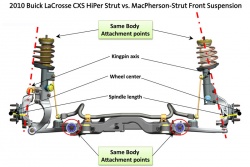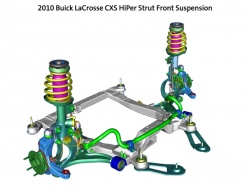  Buick HiPer Strut suspension. Click image to enlarge |
By Jim Kerr; images courtesy GM Canada
The world of automotive technology doesn’t always have to include whiz-bang electronic programs or multi-passenger video displays. Sometimes, new technology appears to be so simple you may ask, why hasn’t someone done this before? Sometimes they have, but the materials weren’t developed yet that would let it survive a driver’s use or abuse. Other times, it is simply that none of the great minds in the industry have thought of it before. There is always room for new ideas, and Buick’s HiPer Strut suspension is one of them.
The HiPer strut suspension design combines a McPherson strut design with some of the benefits of a short arm/long arm design. To understand Buick’s HiPer Strut design, we should first take a look at the other designs. McPherson struts are an economical, lightweight design perfectly suited to economy cars. The strut is a structural part of the suspension, with a shock absorber inside, a coil spring (typically around the shock) and a steering knuckle connected at the bottom end. A lower control arm holds the bottom of the strut in place. A McPherson strut supports the vehicle, holds the tire upright and rotates to allow the tires to steer. Some vehicles use struts at all four corners of the vehicle. They all do the same job of supporting the body, although the rear struts are fixed so they don’t allow the rear wheels to steer.
The Short arm/Long arm design, sometimes called SLA or Double Wishbone design, has a higher cost, higher weight, but has better adjustability and better control of tire angles. This design uses A-shaped upper and lower control arms with ball joints at the outer ends that connect to the steering knuckle. A spring, either coil or torsional, is connected to one control arm to support the vehicle. The control arms hold the tire upright in the correct position, while the knuckle can be rotated on the ball joints to steer the vehicle. The tasks keeping the tire upright and steering are separated.
As a side note, the SLA design has a short upper control arm and longer bottom control arm so the tire will stay vertical during body roll. The lengths and angles of the control arms contribute greatly to how a vehicle handles. Adjustability is a real benefit of this design, where the position of either or both control arms can be adjusted to reduce tire wear and/or maximize traction. The SLA design is typically used on sports cars, premium vehicles or trucks.
 Buick HiPer Strut suspension. Click image to enlarge |
Buick’s HiPer strut design takes features from both. It has a lower cost and weight, good handling partially because of its adjustability, good ride and it will fit right in where a McPherson strut design previously was used, meaning the car’s structural design doesn’t have to be redone. The main body of the HiPer strut design is like a McPherson strut, but instead of mounting the steering knuckle directly to the strut body, a ball joint is now installed on the strut and the top of the knuckle mounts to the ball joint. This allows the knuckle to turn while the strut remains stationary. The HiPer strut design has separated the parts of the suspension that hold the body and tire upright from the operation of parts that steer the vehicle.
The position of the ball joint on the HiPer strut design is adjustable, so tire angles can be closely set for best handling and tire wear. Adding the ball joint also allows the lower spindle length (the part that goes through the knuckle to mount the wheel) to be reduced by 34 per cent. Benefits of this include better steering feel in the steering wheel, reduced high speed shimmy or shake when the wheel hits a bump and less torque-steer when the vehicle is accelerated or braked quickly. Because the upper pivot point for the steering knuckle is now different than the centre line of the strut, the design also improves camber change when the wheels are turned, providing better traction on corners.
If this sounds too technical, I have tried to explain it in simple terms, but suspension design and steering angles are very technical subjects that are worked on by automotive engineers every day. For us as drivers, the benefits are a lightweight suspension design that has the handling characteristics of a premium design. The HiPer suspension is currently offered on the Buick LaCrosse CXS, but I would expect to see it on other vehicles soon.











